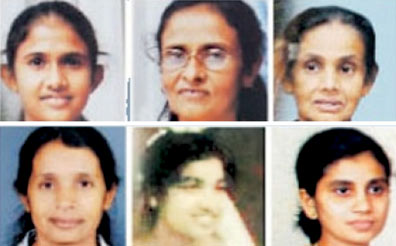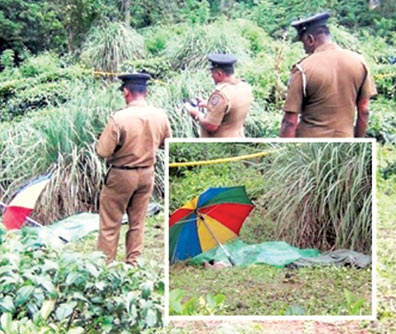A first in criminal investigation
How DNA profiling was used to nab the Kotakethana
serial killer:
by Ranil Wijayapala
 The series of killings in Kotakethana in Kahawatta which compelled
the people to take to the streets in protests, and damage the properties
of suspects saw light at the end of the tunnel, when investigators
eventually tracked the suspect of the DNA profile, found in four murder
scenes - from December 2010 to July 2012. The series of killings in Kotakethana in Kahawatta which compelled
the people to take to the streets in protests, and damage the properties
of suspects saw light at the end of the tunnel, when investigators
eventually tracked the suspect of the DNA profile, found in four murder
scenes - from December 2010 to July 2012.
 |
|
Dr. Ruwan J. Illeperuma,
Senior
Scientist, Genetech Research |
Neil Lakshman, a 35-year-old father of three, also a resident of
Kotakethana, had the DNA profile, identified in the witness samples
collected from the four murder scenes in Kotakethana since 2010.
This solved the mystery of the series of murders in Kotakethana but
raised serious questions about criminal investigations in Sri Lanka.
Had it not been for the DNA traces, the innocent-looking, Neil
Lakshman, although a suspect, would have been still mingling with the
villagers and would have taken his next victim in the village, possibly
an elderly woman in an isolated residence in the hamlet.
But this time around, after analysing the murders in Kotakethana from
2008, the CID team investigating the murder of Nathan Pappu, a tea
plucker from Opatha estate, meticulously planned their approach and on
September 28 netted the perpetrator.
 |
 |
|
Police officers at the
scene of a murder |
A team led by IP Wijethunga under the direction of ASP Samantha
Wijesekara of the CID planned the investigations without leaving room
for the perpetrator to escape or mislead investigators.
Although their prime task was to investigate Nathan Pappu’s murder,
the investigation team believed it was also a part of the series of
killings in Kotakethana since 2008. They felt the perpetrator was
definitely from the area.
The CID team, with the help of the Survey Department mapped out the
places where the murders had occurred and anlaysed the manner in which
it had been committed.
Professionals
In most cases, the perpetrator had taken the body away from the scene
of the crime and had robbed the jewellery of the victim. The days on
which the murders had taken place had also been probed with the help of
professionals but they could not trace a pattern in the dates.
In most cases, the murdered women had been raped but not in the case
of Nathan Pappu, though there had been signs of attempted rape after the
murder.
In their search, for the perpetrator in Nathan Pappu’s killing, they
got vital clues from a fellow villager who had seen a person walking
across the estate on the day in question. The information was given by a
girl who had seen a person running away, when she noticed a person
lurking close to her home and running away when noticed, a few weeks
after the murder of Nathan Pappu was also a vital clue for investigators
to trail the suspects.
However, in an area where questioning by the Police had become
routine, the CID team found it difficult to track people after they were
questioned. They had to question them several times to ascertain whether
they were telling the truth. Neil Lakshman was also among the dozens of
people questioned by the Police.
He was also questioned at the Police station and officers later
visited his home while he was engaged in rubber tapping, from which he
earned a living. CID officers found that though he gave the same answers
in some instances, he contradicted what he had said earlier.
While questioning people with regard to the murder, the CID let go
certain people who were to be subjected to the DNA tests, as they found
it was a single person who was responsible for all the murders in
Kotakethana. This assumption was arrived at after the submissions made
to Court by Dr. Ruwan J. Illeperuma, a senior scientist at the Genetech
Research Institute.
Their objective was to find the person who matched the DNA profile in
the four murder cases, which included two double murders.
Neil Lakshman was among those to be subject to DNA testing on a Court
order. Investigators found that the DNA profile of Neil Lakshman matched
the DNA profiles found in the four murder cases.
After a long wait. the CID arrested Neil Lakshman. He had told one of
his relatives that he would be caught for Nathan Pappu’s murder.
After evading the investigators, Lakshman confessed to Police about
the murders he had committed, the manner in which he had committed them
and the reasons for committing the crimes.
It was either to take revenge or to rob their jewellery or both. He
derived sexual pleasure after murdering them as he felt women did not
like him.
Gruesome murders
Lakshman used various tactics to get his target and at times got the
women out of their homes. He waited hours for his prey and abandoned his
mission when there were disturbances.
Although he studied only up to Grade 4, one would think he was
illiterate but he knew how to get rid of fingerprints and prevent
footprints from appearing, when he committed the gruesome murders.
He wore socks to avoid footprints but had not used socks on his hands
when committing the murders because he knew how to get rid of
fingerprints. He sprinkled water or set fire and got rid of them.
His ailing wife, sister and mother could not believe that Neil had
committed these crimes. Even villagers who were traumatised over the
past few years, when the Police arrested villagers on suspicion could
not believe that Neil Lakshman had committed the crime and assumed it
was just another arrest.
Many arrests had been made in this regard and some of them even faced
jail terms.
The villagers did not have faith in the investigations or in the DNA
tests. Their contention was that all this was done at the behest of
influential people.
The investigations into the killings in Kotakethana and Kahawatta
raised serious questions and even the Police were in a dilemma clearing
those arrested on suspicion, because Neil Lakshman had confessed to the
crime.
Uphill task
However, the only evidence against him was that his DNA profile
matched that of the DNA found on the victims.
He had apparently confessed to the Magistrate regarding the
incidents. The Police and the CID are faced with an uphill task of
resolving these issues and winning the confidence of the people.
The GENETECH Institute, though not a State body, evaluated samples
from the victims in the Kotakethana murders since 2008.
A compelling find in January 2014 led them to believe there was a
common DNA profile akin to the four cases - from December 2010 to July
2012.
After one year, in December 2011 another woman Wijesundara
Mudiyanselage Bandaramenike was murdered and sexually assaulted and the
DNA profile was found to be that of a man, just like in the other cases.
In May 2012, Sethungage Dayawathie and Sethungage Thilakwathie two
sisters were murdered and GENETECH traced the DNA profile to be that of
a man.
This was found by a red stain at the murder scene.
In July 2012, too a mother and her daughter were murdered in
Kotakethana, Kahawatta and were set on fire. Here too the DNA samples
pointed to that of a man.
GENETECH Institute after compiling a DNA database in 2013, found the
four DNA pofiles were from one and the same person and filed a report in
Court on January 24, 2014.
“But this went unnoticed until March 2015. I knew this was the first
case in the history of criminal investigations in Sri Lanka where DNA
evidence established a link between multiple crimes that were separated
by a timeline”, Dr. Illeperuma said.
When called by the defence in the double murder case, where a mother
and her daughter were killed, Dr. Illeperuma gave evidence that the DNA
profiles found in the four murders were the same and did not match any
of the other suspects in custody.
Scientific criteria
This evidence was convincing and the Judge acquitted the other
suspects.
“When I gave evidence on March 10, 2015 I initiated a question that
begged for an answer. I said the common DNA profile didn’t match that of
anyone in custody. Who was this person then, having this DNA profile?
This was the question I posed in Court which needed to be answered”, he
said.
“That was the turning point and at that time, the Police had
initiated investigations on who had this biological specification.
From March 2015, they conducted many investigation and the CID had
discussions on several occasions to track the criminal”.
“We discussed how to narrow down the number of suspects. I gave my
scientific knowledge to screen suspects for DNA testing,” I provided
scientific criteria to establish a scientific base for DNA testing
A group of nine people and another group of five were sent for DNA
testing which was done on a Court order with their written consent.
By analysing 10 or 12 persons, we found that one of them who had the
DNA profile that matched the DNA found at the scene of the crime.
This is the first time in Sri Lanka DNA evidence was used to track
down a suspect. |

